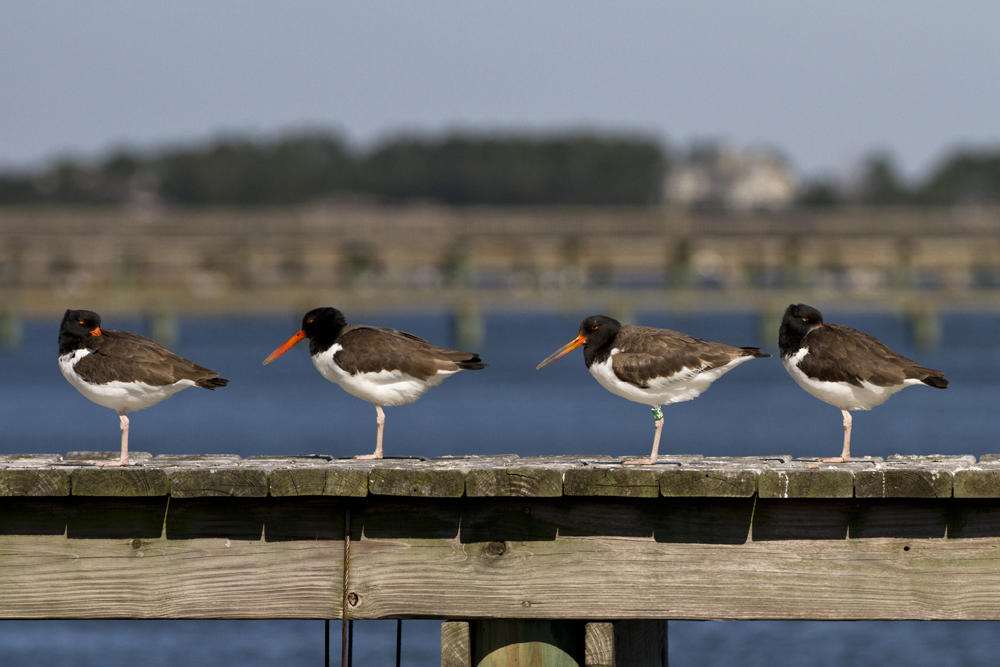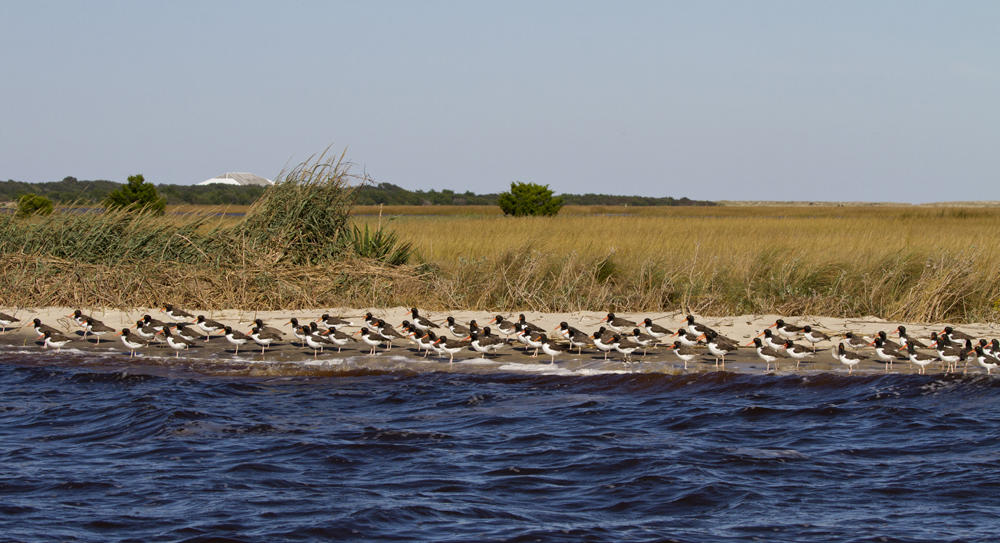As the days grow shorter and fall advances toward winter, many shorebirds are on the move. American Oystercatchers scatter the timing of their fall migration across the calendar from August to November.
The Oystercatcher Range
Some birds that breed in Massachusetts, near the northern extent of their breeding range arrive at wintering areas in Florida during September. Others, like flocks in New Jersey, are prepared to stay late into the year and may even overwinter at favorable sites during mild winters. The oystercatchers that call North Carolina home during the nesting season are no different—some are settling in place for the winter and others have already flown south.
Like many other partners across the oystercatchers' range, Audubon North Carolina tracks their arrivals and departures in North Carolina by resighting banded individuals.

Resighting Banded Birds
Dark Green CYR, seen second on the right in the photo wearing green bands with the unique code “CYR,” was banded this past May as a chick on Lea-Hutaff Island, which Audubon North Carolina manages. Like many of the oystercatchers that nest in the Cape Fear region, CYR will probably stay in the state over the winter, though these oystercatchers move from their nesting territories on barrier island beaches and join migrating and wintering flocks near bountiful foraging habitat.
For Lea-Hutaff oystercatchers, this can mean the marshy western side of Masonboro Island, which is replete with oysterbeds. CYR and its flockmates will spend low tide foraging for shellfish and then roost at high tide on the beachfront of Masonboro Island or on docks near the sound side of the island. The oystercatchers that choose to stay in the same area year-round are called resident birds.
Meanwhile, other migratory North Carolina oystercatchers have relocated to southern wintering areas, including some that hatched on Masonboro Island. Dark Green CWU was banded this June as a chick, one of three siblings that all fledged. Now CWU been resighted in northwest Florida. With 10-15% of the entire U.S. oystercatcher population, the area is one of the largest concentrations in the oystercatchers’ winter range.
Since 2013, Audubon North Carolina has partnered with the North Carolina Coastal Reserve, which includes Masonboro Island, to help monitor nesting oystercatchers and band adults and chicks.

Finally, some North Carolina oystercatchers just migrate within the state. Dark Green CHP nests on Beacon Island in Ocracoke Inlet, and it winters on the Cape Fear River, which is home to the largest wintering flock in the state. It's joined by oystercatchers from New Jersey, Massachusetts, and Virginia and many resident individuals as well.
Areas like Masonboro Island, the Cape Fear River, and Cedar Key in northwest Florida are essential to the health of oystercatchers across the entire Atlantic coast range because they provide a fall stopover or a winter home for large proportions of the population.
Become a Citizen Scientist
These varied strategies—migrating long or short distances or staying put—mean that there are many opportunities in North Carolina, and all across the Atlantic and Gulf coasts as well, to find banded oystercatchers.
Areas like Fort Fisher State Recreation Area and Cape Lookout and Cape Hatteras National Seashores are just a few of the places where it's possible to find banded oystercatchers on migration. Not only is resighting banded birds fun, reporting them to www.amoywg.org adds to what is known about how oystercatchers like CWU and CYR move along the coast and what areas they need to survive.
Click here to learn more about citizen science opportunities available across the state.




